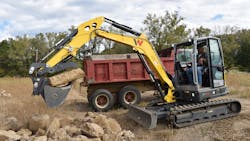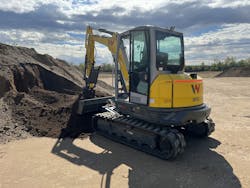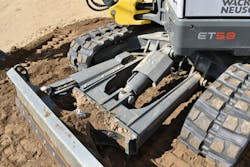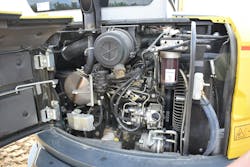The 48-horsepower Wacker Neuson ET58 crawler excavator is part of a family that includes a 4.2-ton machine and a 5-ton zero-tail unit.
Built in Linz, Austria (others in the family will eventually be built in Menominee Falls, Wisconsin), the two most noticeable things about the excavator at first glance are the sturdy-looking coupler and a heavy-duty-looking dozer blade.
Wacker Neuson ET58 Specifications
- Operating weight: 11,138 - 14,079 lb.
- Power: 48 hp
- Maximum dig depth: 13 ft. 2 in.
- Maximum dump height: 14 ft. 7 in.
John Dotto, product application training specialist for Wacker Neuson, was on hand to give Construction Equipment and Independent Union of Operating Engineers Local 649 operator/instructors Andy Schaidle and Matt Ulm a walk-around on the excavator. Appropriately, Dotto starts with the larger, obvious items.
“We have a hydraulic quick coupler factory-installed standard on this machine,” he says. “There are only two manufacturers in the market that are doing that: us and Yanmar. The difference in the system between us and the Yanmar is this is a spring applied hydraulically released system. There's no need for a mechanical safety pin like you see on the other machine.”
Dotto says the machine’s design has some built-in mechanical advantages for power and breakout force.
“When you move up the stick, there is the kinematic system for the bucket,” Dotto says. “Wacker Neuson uses what we call a three-bolt linkage, as opposed to just a simple two-point lever system for bucket kinematics. It gives you a little bit extra range of motion and a little bit better breakout force just because of the geometry of the coupler there.”
How operators evaluate the ET58 excavator
Operator/instructor Matt Ulm challenged the ET58’s power on a hillside.
“We do a lot of digging on slopes, underdrain-type situations, or placement of erosion control [materials like] rip rap,” Ulm says. “I wanted to get it on a slope to see the stability of the machine and how it felt. I also wanted to see how it handled on a slope with that size of a dozer blade on the front of it.”
Ulm dug a two-foot-deep trench simulating burying tile up a bridge abutment. “I wanted to see how much power it had, how quick it was, and how did it break out the hard, compacted soil that was not previously excavated and has been sitting there for quite a while.
“I tried to walk up the slope and pull myself up just because I've done that before on other machines, and I wanted to see how the dozer blade worked on that slope, and I liked it; it had good stability,” Ulm says.
“One of the things that really stuck out to me was the visibility. The machine has very good visibility,” Ulm says. “I like the backup camera. The camera on the back of the machine is on all the time. You don't lose your gauges—your gauges are right there to be able to watch as well as [the display] so I can see behind me as I'm digging up that slope.”
Ulm was also impressed that the 7-inch screen was a manageable size. “It doesn't have a great big screen that takes up a big area,” he says. “So, there's no blind spot by that pillar in the cab. It fits the machine well. That low hood on what I'm calling the right side of the machine lets you see down over to that dozer blade where I was backfilling.”
The excavator is equipped with an optional angle dozer blade. Its size, and girth, for lack of a better word, are impressive.
“The angle blade does come with float, so there's a detent float on the dozer joystick,” Dotto says. “You see the size of the construction not only in the boom structure itself, but also in some of the hardware we use. This is just big, beefy stuff.”
Matt Ulm appreciated the option and saw only one minor issue.
“I liked the dozer blade setup on this machine,” he says. “It’s one of the heaviest-built ones I’ve seen. One of the features I really like is the angle—how I can angle that dozer blade. Most of these compact excavators that I've been on do not have that feature. The only [issue] that I noticed is that to be able to angle that dozer blade, it's a bit farther out in front of the machine, so if you were digging with that blade in front of you, it would be harder to dig right up-close underneath you.
“You'd want to turn the machine around and dig with the dozer blade behind you to actually dig up close,” Ulm says. “If you're in a tight situation, maybe up against a guardrail or traffic, you'd want that dozer blade around on the other side. I did like the being able to angle the blade, backfill, and get my spoil back into the trench. That visibility is phenomenal on this machine to be able to see on both sides of the dozer blade, even off to that right side.”
Trenching with the Wacker Neuson ET58
Operator/instructor Andy Schaidle first chose to dig a straight trench and then a footing or small pad. Afterward, he spent considerable time coupling and uncoupling the bucket, also reversing it to dig with a shovel configuration.
“The breakout force, I don't think it was bad,” Schaidle says. “It might not be as strong as some others I’ve run as far as that size machine. But this material down here is really demanding, too. I feel like the machine’s pretty smooth. If you overcrowded too much, it does get a little jerky, but a lot of them do that same thing.
“One thing I did notice, it doesn’t curl out as far as I would generally like, so if you were up tight next to something and you're trying to dig a straight wall straight down, sitting next to a building or something, or you're going to dig a footing coming off an existing building…you would have to track backwards to get your bucket curl out far enough to dig straight down,” Schaidle says. “I actually had to turn the bucket around backwards from where I was sitting to dig my ditch straight up and down.”
Schaidle says the need to reverse the bucket on a mini excavator comes up more often than one would think.
“One thing I really liked on the coupler feature is it was super easy to do a visual inspection as far as having to touch the ground or whatever to make sure the bucket won't fall off,” he says. “I'd like to play with that quick coupler a little bit more than I did. I can make myself look better with it, but I did think it was fairly easy, even turning the bucket around backwards.”
Both operators used the Geith bucket and thumb combination to pick up rocks and slabs of concrete for loading into a dump truck.
“The biggest thing that I wanted to see was the stability of it,” Ulm says. “We do a lot of concrete removal, a lot of demolition work. And, of course, we're always wanting to get the biggest slab of concrete we can in the truck, or the biggest chunk moved. This thumb would be real handy for it.”
To test stability, Ulm picked up a large chunk and swung around the tracks with it.
“I was pretty satisfied with the stability of the machine. I had a pretty good-sized boulder on there and had to boom down a ways and bounce it a little bit just to see what the stability was,” he says. “I think with the wide track assembly and just the balance of the machine, it handled that thumb and those boulders pretty well.”
Schaidle, on his turn: “I'm very impressed with the stability of that machine and what it can handle it. It is an extremely stable machine. And I've never really seen one with as much ground clearance. That’s got to count for the stability. I don't think you'd have a problem on that machine if you were to, say, tear curb out.”
Attachments and the Wacker Neuson ET58
The ET58 excavator is well prepared for attachment use. Also, hydraulic hoses are routed smartly, and well protected.
“Up the arm, we've got a diverter valve and [with a key], I can switch my auxilary flow from either my thumb circuit or my auxiliary circuit,” Dotto says. "If I have a breaker or a swivel bucket hooked up here, I don't have to take lines off my thumb and I can leave everything plumbed up and just divert the flow in one direction or the other.”
Both operator/instructors were impressed with the power, sensitivity, and responsiveness of the Field Test unit.
“I do like the foot pedal for boom articulation,” Schaidle says. “You can run it smooth. You're not overcomplicating your sticks; a lot of manufacturers want to put so many buttons on there, which I know they're trying to do a bunch and they've got to have a location for things, but I do like the layout of it. I'm pretty pleased with it as far as running the thumb, too.”
The excavator is powered by a 48-horsepower Perkins engine. It’s a European Stage V model.
“You are going to start seeing Stage V engines in a lot of what I'll call global machines, so not in skid steers and compact track loaders, but from manufacturers that sell equipment to the entire world like mini excavators, dumpers, and wheel loaders,” Dotto says.
“The big difference between Stage V and Tier 4-F is the technology. So, for example on this Perkins, it does run a combo DOC and DPF, but that DPF does not have that same regeneration cycle that we all had to learn about when we started getting to Tier 4-F; it doesn't go through the active burn where a light comes on in the cab and maybe I have a ‘Cancel’ button,” Dotto says.
"When the operator hits the 'Cancel' button, it turns the light off, 'I won the game, the light's off,' everything's good," Dotto says. "But what happens is then you go into limp cycles [and end up] having to have machines hooked up to laptops. The Stage V system on this Perkins is going through a constant passive regeneration cycle. So as soon as it hits operating temperature, it's always going through a burn, but it's not a burn in the Tier 4-F old traditional sense where they put out those warnings. On this machine, there's no inhibit switch and the DPF filter itself has the same life expectancy as the engine.
"In the past, a Tier 4-F DPF system on other equipment would have a service life anywhere between, say, 1,500 and 3,000 hours and that's all totally dependent on how you operate that piece of equipment," Dotto says. "If you don't run them hard, you're gonna plug them up quicker. On this DPF system, it's meant to last the life of the engine so there's really no service interval on that."
Schaidle felt the engine power translated nicely to overall performance.
"It's a capable machine," Schaidle says. "I think the more I run it, the more I actually like it. I do like that I can run full tilt on it, full angle on that blade, and I'm not generally running over my windrow. A lot of machines, it seems like when you go to a full angle, you want to start climbing up on your window and I didn't notice that as bad with this one.
"It's got power, you can feel everything, and one thing for sure is you can definitely multitask," Schaidle says. "I can travel and swing and boom. Obviously if you go to run something like your auxiliary, the blade, or the the thumb, it'll take power away, which is to be expected. But it's one of the best ones I've run, as far as I can track and travel and I can boom swing, and it doesn't rob power like most generally do. I think a lot of them aren't built for the heavy-duty role as this one is. This one's real heavy duty."
About the Author
Frank Raczon
Raczon’s writing career spans nearly 25 years, including magazine publishing and public relations work with some of the industry’s major equipment manufacturers. He has won numerous awards in his career, including nods from the Construction Writers Association, the Association of Equipment Manufacturers, and BtoB magazine. He is responsible for the magazine's Buying Files.




